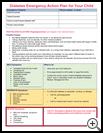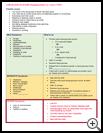
Diabetes: Blood Glucose Monitoring (BGM)
________________________________________________________________________
KEY POINTS
- Testing your child’s blood glucose (sugar) is an important part of managing diabetes. It is called blood glucose monitoring (BGM).
- Your child’s healthcare provider will tell you when and how often you need to check your child’s blood glucose levels and what your child’s target range should be. Ask your provider to tell you and write down what you should do if your child’s blood glucose result is too high or too low.
- Always take your child’s blood glucose records to checkups with your child’s healthcare provider or certified diabetes educator.
________________________________________________________________________
Why is blood glucose testing important?
Testing your child's blood glucose (sugar) levels, also called blood glucose monitoring (BGM), is an essential part of managing type 1 diabetes. Your child’s provider may recommend BGM also if your child has type 2 diabetes. Testing your child’s blood glucose regularly can:
- Help you know if your child’s blood glucose is within the target range. Staying in a target range can help prevent or delay long-term problems caused by high blood glucose such as heart, kidney, eye, nerve, and circulation problems.
- Help you know if the blood glucose level is too low or too high and if extra treatment is needed
- Help you know how much and which type of medicine to use depending on the healthcare provider’s advice
- Help prevent low blood glucose during the night
- Help you manage your child’s diabetes while your child is sick
- Let you know if you need to do a ketone test
- Help you learn the effects of certain foods, physical activity, and stress on your child’s blood glucose levels
- Help your child’s healthcare provider know if changes in treatment are needed
- Let you recheck your child’s blood glucose level if your child has symptoms and the continuous glucose monitor (CGM) reading is normal
A CGM is a device worn on the skin that reads blood glucose levels at set times. Talk to your child’s healthcare provider about the best device for your child’s needs.
What supplies are needed?
Doing a blood test requires:
- Needle or lancet device: A small needle (called a lancet) is used to get a drop of blood for the test. Some lancet devices can be adjusted for different depths. This can be good for young children and for people with tender skin. Some lancet devices can also be adjusted to prick a finger, palm, arm, or other parts of the body. Be sure to use a new lancet each time. A sharp and clean lancet helps prevent injury and infection.
- Blood glucose meter: There are many types of blood glucose meters and results from one meter may be different from another. It doesn't matter which type of meter you choose, as long as you always use the same meter. Bring the meter to each clinic visit. A healthcare provider can get a record of the test results from the meter.
When looking for a blood glucose meter, make sure it:
- Is accurate in the area where it will be used, in cool or hot temperatures, high humidity, or high altitude
- Can store at least the last 100 test values to share with a healthcare provider during checkups
- Is small enough to carry in a handbag or backpack
- Is easy to keep clean and care for
Your child’s healthcare provider, nurse, pharmacist, or certified diabetes educator will show you how to use your child’s meter. Some meters may need to be checked for accuracy with a control solution or strip. Others need specially coded test strips.
- Test strips are put into the blood glucose meter: When choosing test strips, make sure they work in the meter you are using. Look for strips that need only a small drop of blood and can draw the blood into the strip. If your child has health insurance, make sure you know what types of strips your child’s insurance will pay for before choosing a meter. The test strips are usually more expensive than the meter itself. Be sure you know how much test strips cost before choosing a meter.
How is the blood glucose test done?
To get a drop of blood:
- Wash your hands and the area to be tested with warm water and soap. This increases blood flow and makes sure there is nothing on the skin that may change the reading. It also helps prevent infection. Do not wipe the skin with alcohol. Any trace of alcohol left on the skin will interfere with the test. If away from home, use alcohol-free travel wipes to clean the area.
- Air dry the area completely before pricking the skin.
- Use the lancet to prick your child’s skin.
- Put the drop of blood on the test strip. (If a test strip has been in a cooler or refrigerator, bring it to room temperature before you use it.) Make sure you completely cover the required area on the strip with blood. Putting too small a drop on the strip is a common mistake that causes inaccurate readings on the meter.
- Put the strip in the blood glucose meter to measure the glucose level.
Avoid incorrect blood glucose results by checking that:
- The skin is clean.
- The meter is clean.
- The test strip is not expired.
- The meter is set up for the current box of test strips. Run a control strip if necessary.
- The meter and test strip are at room temperature.
- The drop of blood is big enough.
Some meters are more accurate than others. If the blood glucose is very high or very low, test it a second time to double check the results. Talk to a provider about the accuracy of the meter you’re using.
When should I do a blood glucose test?
Check your child’s blood glucose levels as often as advised by your child’s healthcare provider. Ask your healthcare provider what your child’s blood glucose target range should be. Also ask your provider to tell you and to write down what you should do if your child’s blood glucose result is too high or too low.
Some common testing times include first thing in the morning, before meals or physical activity, 2 hours after meals, before driving, at bedtime, and any time you feel like your child’s blood glucose may be too high or too low. You should also check your child’s blood glucose when your child is feeling ill.
You may need to test more often when your child’s diabetes medicine or any other medicines are changed. Certain medicines can affect blood glucose and how other medicines work.
Should I keep track of test results?
It is important to keep track of your child’s blood glucose test results. Learning what affects your child’s blood glucose can help control it better. Keep separate records even if the glucose meter stores results in case the meter breaks. It’s a good idea to keep track of:
- The date and time of the test
- Any symptoms your child has
- The blood glucose value
- If your child was physically active, was sick, or felt stressed
- What your child ate before bedtime or physical activity
- When your child has low blood glucose reactions and what you think might be possible causes
Always take your child’s blood glucose records to checkups with your child’s healthcare provider or certified diabetes educator.
Last modified: 2022-02-23
Last reviewed: 2022-02-05


